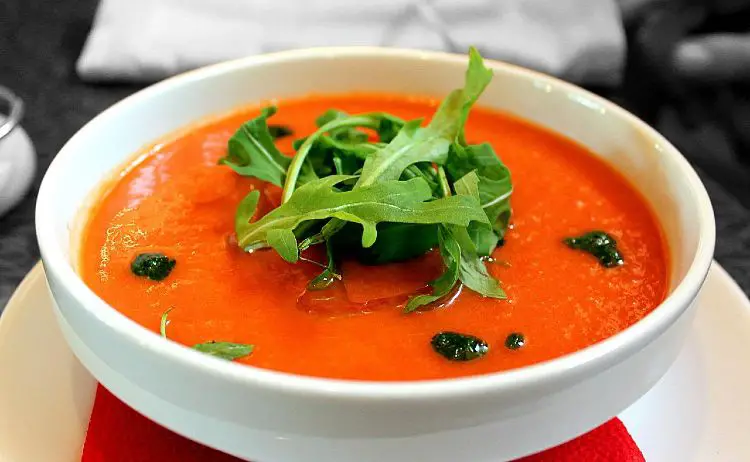Can You Freeze Gazpacho?
The summer months challenge anyone to venture into the kitchen to cook food. That is the last thing you like to do. However, you have to eat. So, gazpacho is the perfect food because it is easy to make. Secondly, it is a filling recipe that keeps you satiated for a long time.
What is gazpacho, and from where has it originated? Gazpacho is a vegetable soup that can contain almost any vegetable, stale bread, olive oil, vinegar, garlic, and nuts. It is a Spanish recipe that draws influence from Eastern Europe and Middle East cuisines. So, you have an exciting variety of flavors and ingredients in a versatile meal, gazpacho.
Gazpacho is an ancient recipe that has sustained itself over the years with frequent improvisations. The modern-day gazpacho contains tomatoes, onions, cucumbers, bell peppers, avocado, etc. Since it is an easy recipe, preparing gazpacho in bulk is not new. Therefore, there can be queries about preserving the dish.
Can You Freeze Gazpacho?
If you are left with more gazpacho than you can consume, you can freeze the soup and finish it later. As you can blend the soup in different ways, smooth or chunky, the freezing methods can differ slightly. We shall discuss both methods here.
How Do You Freeze Gazpacho?
You can freeze gazpacho in two ways, depending on how you prepare it.
Freezing Smooth Gazpacho
While it is possible to freeze smooth gazpacho in bulk quantities, we recommend freezing them in consumable portions to make it convenient for defrosting. Otherwise, you could waste the gazpacho because refreezing the gazpacho is not viable.
- Filter the prepared gazpacho through a sieve to get silky smooth gazpacho for freezing.
- Separate the dish into small servings convenient for consumption. Pour them into appropriately sized freezer-safe ziplock bags. Alternatively, you can pour them into an airtight Tupperware or glass container.
- We recommend using freezer bags because it is convenient to lay them flat inside the freezer. Seal the bags properly after expelling excess air from the bags. Once the gazpacho solidifies, you can keep the bags upright and save space.
- We advise leaving a gap of an inch or two if you store the gazpacho in containers. It allows the soup to expand.
- We recommend noting down the freezing date on the ziplock bags or the containers to track the freezing process.
Freezing Chunky Gazpacho
While freezing chunky gazpacho, you need to exercise care because the chunks in the soup might not freeze well, depending on the vegetables or other ingredients you use when preparing the recipe. However, the basic freezing principles remain the same. So, we shall discuss the general precautions to take when freezing chunky gazpacho.
- Vegetables like cucumber have high water content. So do fruits like tomatoes. Therefore, it can be challenging to freeze them. There could be ice crystal formation leading to the soup becoming mushy. However, the heartening aspect is that the soup is liquid. So, it is easy to blend such vegetables. But, we still do not recommend freezing cucumbers.
- The bread pieces also pose problems while freezing because they can disintegrate into the soup and disturb its texture. Again, the solution is blending the soup after thawing it.
We again recommend freezing chunky gazpacho in servable quantities to prevent wastage. You can pour the soup and the chunks into freezer-safe ziplock bags. Seal the bags well after removing excess air. Note the freezing date on the bags before pushing them deep into the freezer.
How Long Can You Freeze The Gazpacho?
The frozen gazpacho can remain consumable for six to eight months after the freezing date. Hence, noting the date is significant.
How Do You Defrost The Frozen Gazpacho?
Gazpacho is generally served cold. Therefore, we do not recommend defrosting the soup in a microwave. You can keep the frozen soup on the kitchen counter to thaw up to 90% before continuing the defrosting procedure in the fridge. It saves time. However, the best method is thawing the gazpacho inside the refrigerator overnight. The soup defrosts naturally and becomes ready for consumption the following morning.
If you have frozen the smooth gazpacho, we recommend giving the soup a quick whip in the blender to restore its original consistency. Whipping the soup allows for the reintegration of all ingredients and smooths them out.
If you have frozen the chunky gazpacho, we recommend stirring the soup before serving. First, however, we advise checking whether all the vegetables have defrosted uniformly. A better option is to blend the soup smooth and add vegetables and herbs afresh. It helps restore the flavor and texture better.
Can You Refreeze Gazpacho?
We do not recommend refreezing gazpacho because it affects the recipe’s texture and taste.
Can You Freeze Store-Bought Gazpacho?
It is possible to freeze store-bought gazpacho. However, we advise checking the ingredients before doing so.
Can You Freeze Watermelon Gazpacho?
Watermelon has high water content. So, there can be ice crystal formation. So, theoretically, you can freeze watermelon gazpacho. But, we do not recommend freezing watermelon gazpacho. If you wish to freeze it, we do not advise freezing it for more than 30 days.
Can You Freeze Green Gazpacho?
There should be no issues freezing green gazpacho. You can freeze it the way described here.
Can You Freeze Alvalle Gazpacho?
While it is technically possible to freeze Alvalle gazpacho, we do not recommend it because the varying freezing and defrosting speeds of its constituents can impair its taste.
Can You Freeze Avocado Gazpacho?
Avocado freezes well. So, there should be no concerns about freezing avocado gazpacho. You can freeze it the way described here and preserve it for two months.
Can You Freeze Fresh Gazpacho?
Freezing fresh gazpacho is possible. We have discussed the entire procedure in detail here.
Can You Freeze Tomato Gazpacho?
Compared to watermelon and cucumbers, tomato contains less water. So, you can freeze tomato gazpacho and maintain its freshness for extended periods.
Final Thoughts
Gazpacho is one of the most straightforward dishes to prepare and consume. It is best served fresh and at room temperature. But, if you have prepared excess gazpacho, you can explore freezing gazpacho and consume it subsequently. So, can you freeze gazpacho? The answer is simple. Yes, you can.


